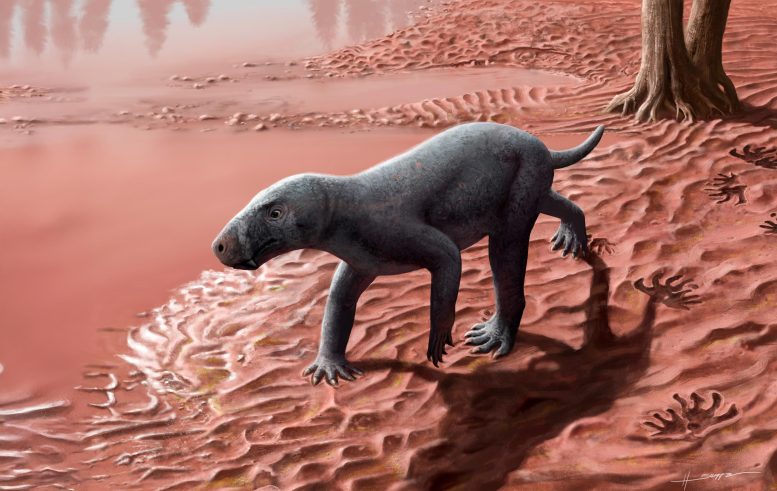
There’s no shortage of craters on rocky bodies in the solar system, but one of the largest scars is borne not by a planet but by a moon. Researchers have now dated that maw—the South Pole–Aitken basin on Earth’s Moon—and found an age inconsistent with that of other lunar impact basins. The finding suggests that the Moon might have had a broader window of impact bombardment early on in its history than scientists thought and calls into question theories about the evolution of the solar system. These results were published in Nature Astronomy.
“It was a bad day on the Moon.”
The South Pole–Aitken basin is a sight to behold—a 2,500-kilometer-wide depression, roughly a quarter of the Moon’s circumference. “This thing is big,” said Katherine Joy, a planetary scientist at the University of Manchester in the United Kingdom.
Scientists think the basin, on the farside of the Moon, formed early in the Moon’s history when a roughly 200-kilometer-wide impactor slammed into the surface. For comparison, the impactor that formed the Chicxulub crater on Earth was only about 12 kilometers in diameter.
“It was a bad day on the Moon,” Joy said.
The Timing of an Impact
Researchers have long sought to determine the age of the South Pole–Aitken basin. Impacts are the primary process that shaped early solar system formation and evolution, so determining when major events occurred is important, said Daniel Moriarty, a planetary scientist at NASA Goddard Space Flight Center and the University of Maryland who was not involved in the research. “South Pole–Aitken is an incredibly important moment in time to pin down.”
To that end, Joy and her collaborators recently analyzed a fragment of NWA 2995, a lunar meteorite. Just as Martian meteorites allow scientists to study bits of Mars in the laboratory, lunar meteorites offer an up-close look at the Moon and complement the rock samples brought back by Apollo astronauts. NWA 2995 was found roughly 2 decades ago in Algeria, and it’s thought, on the basis of its chemistry, to contain minerals that crystallized during the South Pole–Aitken basin–forming impact.
The researchers dated 19 zircon and phosphate grains in the meteorite by analyzing their uranium and lead contents. Uranium, a radioactive element, decays steadily to lead. The ratio of these elements present within a mineral grain therefore acts as a clock counting time since the mineral formed.
The team found ages that clustered tightly around 4.33–4.32 billion years ago. That’s evidence that these minerals formed in one event, and the most likely suspect is the South Pole–Aitken basin–forming impact, Joy said. “We think that they were formed during the impact event itself.”
If that’s true, the South Pole–Aitken basin was formed at least 100 million years earlier than other large lunar impact basins like Imbrium and Serenitatis, which are thought to be no more than 4.2 billion years old.
Have Planets, Will Migrate
A leading theory to explain the bombardment that formed large impact craters on the Moon and other rocky bodies predicts a more recent window of chaos extending from only about 4.2 billion to 3.8 billion years ago.
That theory is that some of the gas giant planets initially formed closer to the Sun but migrated outward over time. Such large-scale planetary migration would have gravitationally scattered asteroids and comets, some of which would have been flung into the inner solar system and impacted objects like the Moon. “Everything went to pot, in British parlance,” Joy said.
“There are things flying around the solar system regardless of what the outer planets are doing.”
Discovering that the South Pole–Aitken basin is significantly older than other large lunar basins calls that theory into question. “Maybe there wasn’t this big cataclysmic episode,” Joy said.
Moriarty contended that it’s premature to discard the theory of late heavy bombardment. Maybe the South Pole–Aitken basin was created by an impactor completely unrelated to planetary migration, he said. “There are things flying around the solar system regardless of what the outer planets are doing.”
Plus, the date the researchers determined hinges on just one rock sample, he said. It will be key to compare that measurement with information from lunar samples collected directly from the basin itself, Moriarty said. China’s Chang’e-6 mission returned rocks from the South Pole–Aitken basin earlier this year, and NASA’s Endurance mission, currently a concept, is slated to gather more. Endurance would traverse 2,000 kilometers of the basin and return anywhere from 2 to 100 kilograms of rock to Earth for analysis. “I really hope this mission happens,” Joy said.
—Katherine Kornei (@KatherineKornei), Science Writer










Leave a Comment